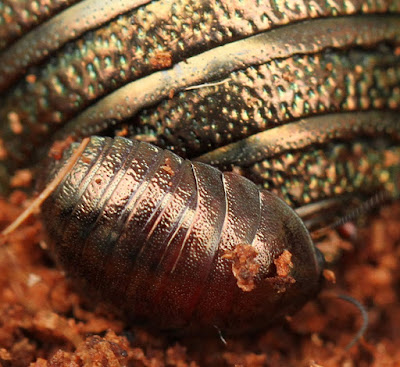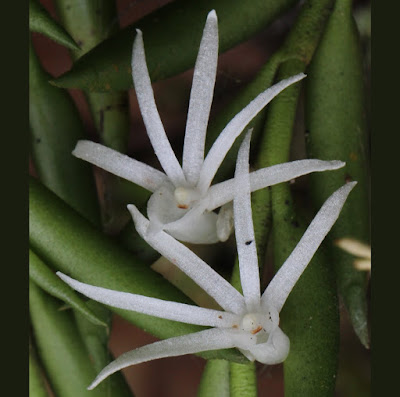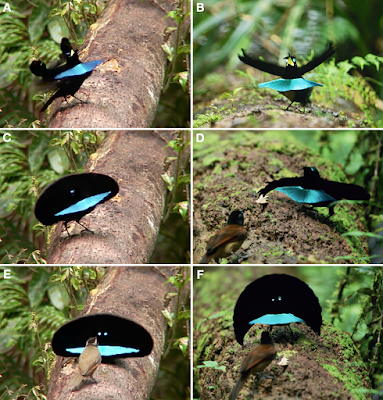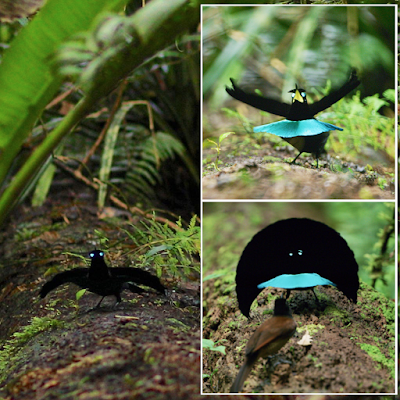[Most Recent Entries] [Calendar View]
Tuesday, April 17th, 2018
| Time | Event | ||
| 3:39a | [Entomology • 2018] Rediscovered and New Perisphaerine Cockroaches (Blattodea: Blaberidae) from SW China with A Review of Subfamilial Diagnosis
Abstract The taxonomic records of Chinese perisphaerine cockroaches were scattered in literature, and therefore a dedicated study is desired to update our knowledge. This paper reviews the subfamilial diagnosis and Chinese species, mostly from southwestern China. We provide high-definition habitus photos and drawings, the latter emphasizes the genitalia of both sexes, which are generalized with diagrams, abstracted from specimens examined. A total of 18 species are recorded in four genera, including Perisphaerus, or pill cockroach, the type genus of the subfamily. Two new genera and three new species are proposed: Achatiblatta achates gen. & sp. nov., Frumentiforma frumentiformis gen. & sp. nov., and Pseudoglomeris montana sp. nov.. Pseudoglomeris has five new junior synonyms: Corydidarum, Trichoblatta, Kurokia, Glomerexis, and Glomeriblatta; the following combinations are thus revived or new: Ps. aerea comb. nov., Ps. angustifolia comb. nov., Ps. beybienkoi comb. nov., Ps. fallax comb. nov., Ps. magnifica comb. rev., Ps. montshadskii comb. nov., Ps. nigra comb. nov., Ps. sculpta comb. nov., Ps. semisulcata comb. rev., Ps. tibetana comb. nov., and Ps. valida moderata comb. nov.. The following species are revalidated and combinations revived: Pe. pygmaeus comb. rev., Ps. dubia comb. & sp. rev., and Ps. planiuscla comb. & sp. rev. Keywords: Blattodea, Dictyoptera, new species, new synonym, Perisphaerinae, revision Xin-Ran Li, Li-Li Wang and Zong-Qing Wang. 2018. Rediscovered and New Perisphaerine Cockroaches from SW China with A Review of Subfamilial Diagnosis (Blattodea: Blaberidae). Zootaxa. 4410(2); 251–290. DOI: 10.11646/zootaxa.4410.2.2 | ||
| 10:14a | [Botany • 2018] Afropectinariella (Vandeae, Orchidaceae), A New Genus of the Angraecum Alliance
Abstract A recent phylogenetic study showed that species assigned to the newly recognised genus Pectinariella Szlach., Mytnik & Grochocka (previously treated as Angraecum Bory sect. Pectinaria Benth.) are polyphyletic, comprising a clade with species primarily in Madagascar and the Western Indian Ocean islands (including the type) and another non-sister clade whose members occur in continental Africa and the Gulf of Guinea islands. In order to render Pectinariella monophyletic, the five continental African species must therefore be removed. A new genus, Afropectinariella M.Simo & Stévart, is described and the following combinations are made: Afropectinariella atlantica (Stévart & Droissart) M.Simo & Stévart, Afropectinariella doratophylla (Summerh.) M.Simo & Stévart, Afropectinariella gabonensis (Summerh.) M.Simo & Stévart, Afropectinariella pungens (Schltr.) M.Simo & Stévart and Afropectinariella subulata (Lindl.) M.Simo & Stévart. Keywords: Angraecoid orchids, continental Africa, Malagasy and Indian Ocean islands, Pectinaria, phylogenetics, taxonomy Taxonomy Afropectinariella M.Simo & Stévart, gen. nov. Type: Afropectinariella doratophylla (Summerh.) M.Simo & Stévart [≡ Angraecum doratophyllum Summerh.].Etymology: The name of the genus is based on the geographic distribution of its five species, all of which occur in Africa and the generic name Pectinariella in which they were previously placed. Diagnosis: Afropectinariella resembles the related genera Dolabrifolia and Pectinariella in having a sessile ovary, i.e. without a pedicel and with a very short peduncle that is hardly developed, but differs from Dolabrifolia by its elongate leaves that are never compressed laterally (vs. imbricate and laterally compressed) and from Pectinariella by its transversely oval lip that is wider than long (vs. the lip longer that wide) and its occurrence in continental Africa and Gulf of Guinea islands (vs. Madagascar and adjacent islands). Afropectinariella atlantica (Stévart & Droissart) M.Simo & Stévart, comb. nov. Angraecum atlanticum Stévart et al. (2010: 253). Type: Equatorial Guinea (Rio Muni). Monte Alén National Park: Engong inselberg, .... Afropectinariella doratophylla (Summerh.) M.Simo & Stévart, comb. nov . Angraecum doratophyllum Summerhayes (1937: 465). Type: São Tomé and Príncipe (São Tomé Island) Vanhulst (Macambrará): virgin forest, 1,050–1,200 m alt., .... Afropectinariella gabonensis (Summerh.) M.Simo & Stévart, comb. nov. Angraecum gabonense Summerhayes (1954: 587). Type: Gabon. Upper Ngounyé River, Nimalaba, N. E. of Les Echiras, .... Afropectinariella pungens (Schltr.) M.Simo & Stévart, comb. nov. Angraecum pungens Schlechter (1906: 163). Type: Cameroon. Man O’War Bay, auf Baümen bei Kriegschiffhafen, .... Afropectinariella subulata (Lindl.) M.Simo & Stévart, comb. nov. Angraecum subulatum Lindley (1837: 206). Type: Nigeria. Nun River: s. d., .... Murielle Simo-Droissart, Bonaventure Sonké, Vincent Droissart and Tariq Stévart. 2018. Afropectinariella (Vandeae, Orchidaceae), A New Genus of the Angraecum Alliance. PhytoKeys. 96: 79-86. DOI: 10.3897/phytokeys.96.23933 Résumé: Une analyse phylogénétique récente a montré que les espèces attribuées au nouveau genre Pectinariella Szlach., Mytnik & Grochocka (anciennement Angraecum Bory sect. Pectinaria Benth.) forment un groupe polyphylétique, comprenant un clade avec des espèces présentes principalement à Madagascar et dans les îles de l'ouest de l'Océan Indien (incluant le type) et un autre clade qui ne lui est pas apparenté et dont les espèces sont distribuées en Afrique continentale et dans les îles du Golfe de Guinée. Afin de rétablir la monophylie du genre Pectinariella, les cinq espèces d’Afrique continentale et des îles du Golfe de Guinée doivent donc en être exclues. Un nouveau genre, Afropectinariella M.Simo & Stévart, est décrit et les combinaisons suivantes sont proposées: Afropectinariella atlantica (Stévart & Droissart) M.Simo & Stévart, Afropectinariella doratophylla (Summerh.) M.Simo & Stévart, Afropectinariella gabonensis (Summerh.) M.Simo & Stévart, Afropectinariella pungens (Schltr.) M.Simo & Stévart et Afropectinariella subulata (Lindl.) M.Simo & Stévart. | ||
| 4:37p | [Ornithology • 2018] Distinctive Courtship Phenotype of the Vogelkop Superb Bird-of-Paradise Lophorina niedda Mayr, 1930 Confirms New Species Status Abstract The birds-of-paradise (Aves: Paradisaeidae) are a quintessential example of elaborate ornamental diversification among animals. Ornamental evolution in the birds-of-paradise is exemplified by the presence of a highly integrated courtship phenotype, which is the whole package of plumage ornaments, behaviors and sounds that each species uses during courtship. Characterizing a species’ courtship phenotype is therefore a key part of evolutionary and taxonomic investigation in the group. With its unprecedented transmogrification from bird-like form into something abstract and otherworldly, the courtship phenotype of the Superb Bird-of-Paradise, Lophorina superba, is one of the most remarkable of all. Recent research by Irestedt et al. (2017) suggests that the genus Lophorina is not a single species but is likely a complex of three allopatric species spanning the island of New Guinea: L. niedda in the Bird’s Head Peninsula of the west, L. superba throughout the central cordillera and L. minor in the Papuan Peninsula of the east. Of these, niedda is the most phenotypically divergent with plumage traits hypothesized to possibly produce differences in ornamental appearance during display. However, the whole courtship phenotype of niedda has not been documented and so the actual extent of differences in ornamental appearance during courtship remain unknown. Here we analyze the first audiovisual recordings of niedda and compare its courtship phenotype with superba to test the hypothesis of potential differences in ornamental appearance. Our main goals are to: (1) provide the first description of the courtship phenotype of niedda in the wild, (2) determine if and how the niedda courtship phenotype differs from superba and (3) evaluate any uncovered differences in light of niedda’s newly recognized species status. Our secondary goal is to provide a more thorough characterization of courtship phenotype diversity within the genus Lophorina to facilitate future comparative study within the genus and family. Results show that the niedda courtship phenotype differs substantially from superba in numerous aspects of ornamental appearance, display behavior and sound. We highlight six key differences and conclude that the new species status of niedda is corroborated by the distinctly differentiated ornamental features documented here. With full species status, niedda becomes the fourth endemic bird-of-paradise to the Bird’s Head region of Indonesian New Guinea (i.e., the Vogelkop Peninsula), a fact that underscores the importance of this region as a center of endemic biodiversity worthy of enhanced conservation protection. Conclusions Given the substantial differences in so many aspects of the niedda courtship phenotype combined with the acute geographic isolation of niedda populations from superba populations, leaves little doubt that niedda deserves full species status as proposed by Irestedt et al. (2017). The species validity niedda underscores the importance of Indonesian New Guinea’ Bird’s Head and Bird’s Neck eco-regions (i.e., the Vogelkop Peninsula) as a center of endemic biodiversity that deserves particular attention from the conservation community. Among birds-of-paradise alone, L. niedda now joins the three other montane species endemic to the region (Astrapia nigra, Paradigalla longicuda, and Parotia sefilata) and opens the door for additional systematic scrutiny of the entire avifauna of the Bird’s Head (Vogeklop) region, including the other birds-of-paradise at middle and upper elevations (e.g., Drepanonris albertisi and Epimachus fastosus). Given that the Bird’s Head region was the first part of New Guinea to be ornithologically explored, and discovery of new species of birds-of-paradise was the main driver of exploration, it is surprising that the distinctive features of the niedda courtship phenotype, and therefore the species status of this unique population, have remained elusive for so long. Yet this fact underscores the need for continued exploration of New Guinea’s forests and further systematic investigation of all taxa, including those like the avifauna which are often considered to be relatively well known. Edwin Scholes and Timothy G. Laman. 2018. Distinctive Courtship Phenotype of the Vogelkop Superb Bird-of-Paradise Lophorina niedda Mayr, 1930 Confirms New Species Status. PeerJ. 6:e4621. DOI: 10.7717/peerj.4621 Martin Irestedt, Henrique Batalha-Filho, Per G. P. Ericson FLS, Les Christidis and Richard Schodde. 2017. Phylogeny, biogeography and taxonomic consequences in a bird-of-paradise species complex, Lophorina–Ptiloris (Aves: Paradisaeidae). Zoological Journal of the Linnean Society. 181(2); 439–470. DOI: 10.1093/zoolinnean/zlx004 |
| << Previous Day |
2018/04/17 [Calendar] |
Next Day >> |









